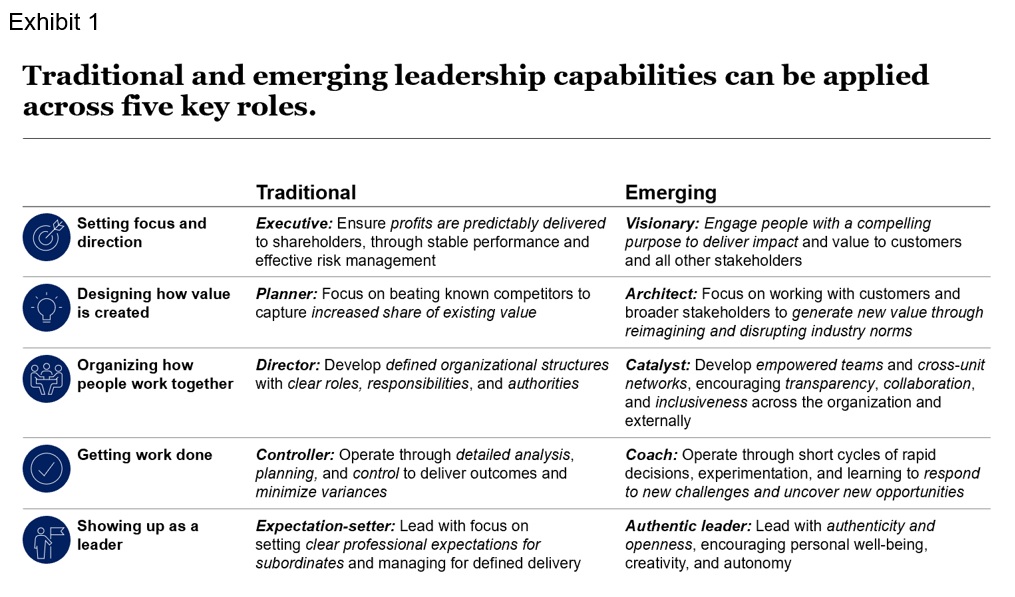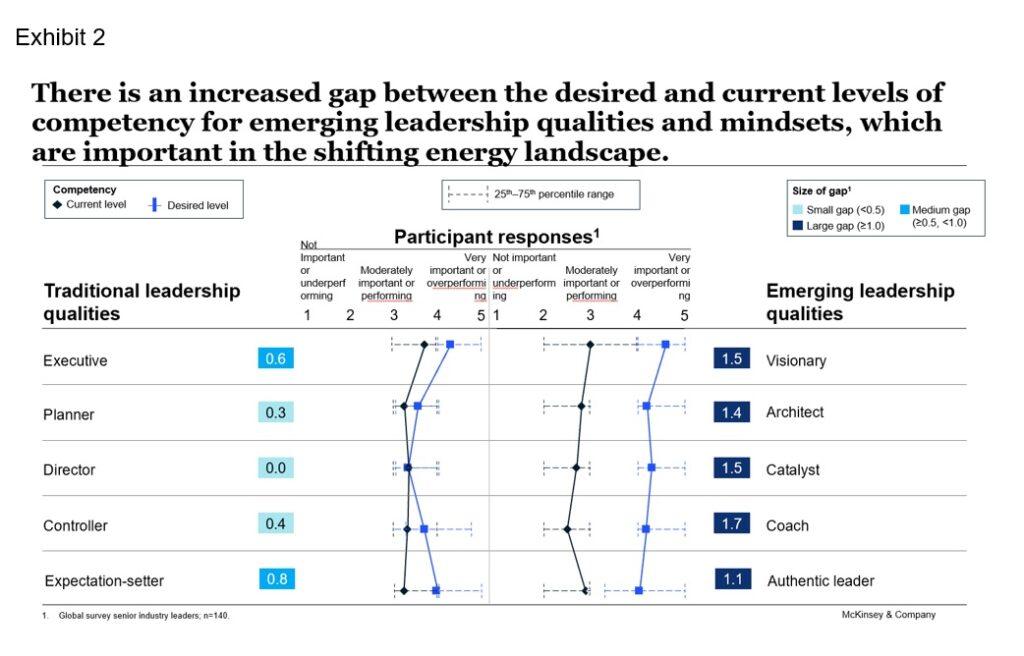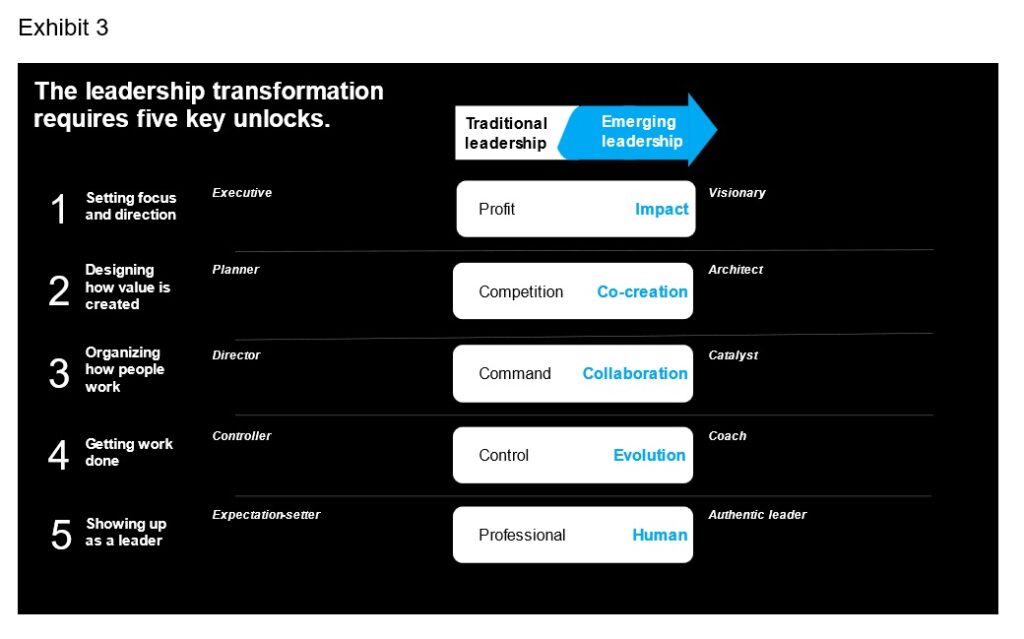Industry chiefs need to transform themselves and their organizations to succeed.
By: Anton Derkach, Ignacio Fantaguzzi, Neil Pearse, and Micah Smith – McKinsey & Company
Technological, economic, regulatory, and geopolitical forces are driving a rapid evolution of the global energy landscape. The trilemma of balancing energy security, affordability and decarbonization is driving uncertainty around the global energy future.
The current energy transition is larger in scale and more complex than previous ones due to the many and sometimes divergent drivers of the transition. As one industry CEO put it: “We’ve now moved from a largely internal, incremental agenda, to a whole set of existential risks and opportunities.”
On one hand, increasing urgency around climate change and decarbonisation is driving the transition to cleaner energy sources.[1]
On the other hand, the post-pandemic rebound in energy demand, coupled with recent supply-side constraints, have revealed the magnitude of the challenge in achieving climate-change ambitions. Global energy demand and supply-side variability are expected to increase over the next decade. Until alternative energy sources are universally efficient, scalable, and affordable, traditional energy sources and related infrastructure will continue to play an essential role.
These considerations introduce a high degree of uncertainty about the path ahead. One thing is clear, however: the search for sustainable, reliable, and affordable energy will be at the core of global aspirations.
Five ways leaders can transform to succeed in this shifting landscape
These unprecedented and evolving challenges need to be tackled by all company leaders in the energy sector, from pure-play, new-energy startups to more traditional oil and gas companies balancing old and new business models, risk profiles, and cultures.
We see companies and leaders, especially in the energy sector, needing to operate with substantially greater speed and entrepreneurialism and developing fresh ways of collaborating, as well as attracting, retaining, and re-training talent..
We interviewed 15 C-suite executives across energy sector organizations to gain their perspectives on the critical leadership capabilities for success in this new energy era.[2] The interviews were complemented by a global survey of more than 140 senior industry leaders. Finally, we layered in data from our extensive body of leadership research and decades of experience helping organizations navigate leadership transformations.
Based on our experience and research, we defined five key roles that leaders typically perform, and identified two broad categories of leadership qualities and mindsets, which we have called “traditional” and “emerging” (Exhibit 1).

The survey results illustrate widespread agreement among respondents on the importance of emerging leadership qualities and mindsets to success in the new energy environment, while reiterating the ongoing relevance of traditional qualities (Exhibit 2). We observed a larger gap between desired and current levels of competency for emerging leadership qualities and mindsets.
In terms of emerging qualities, numerous respondents highlighted the importance of meeting stakeholder expectations, with growing pressure on energy firms beyond creating value for their shareholders. There is clear recognition of the need for new leadership approaches to operate through shorter decision cycles and with greater experimentation.

Shifting one’s mindset and embracing emerging leadership qualities can be a challenge for senior leaders, but there is also a great opportunity here. During our research, many sector leaders expressed excitement about building and leading new kinds of organizations, designed to succeed today and in the future.
What does this leadership transformation require? We see it as including five key unlocks.(Exhibit 3).

1. Setting focus and direction: Beyond profit to impact
In today’s information-rich open environment, leaders are well-placed to deeply understand how their organizations will add unique value to key stakeholders. The purpose of an organization now extends beyond generating shareholder returns to the role it plays in benefiting society.
The energy sector is becoming keenly aware of this. The CEO of a downstream company emphasized what this means for leadership: “In today’s world, we need to include communicators in our leadership to help us find an emotional attachment to what we do. Their involvement will help demonstrate how using practical solutions to do things more sustainably can be exciting and inspiring.”
A strongly held sense of corporate purpose is a company’s unique affirmation of its identity and embodies what the organization stands for. Future-ready companies recognize that purpose helps attract, retain and develop talent..
Crafting a compelling, purposeful narrative is particularly important for companies navigating the energy transition. A balance may then need to be struck between the past and the future in a way that is coherent and inspiring for employees in all parts of the business. On maintaining this balance, one executive reflected: “We originally got this wrong and over-indexed on the newer businesses when describing our purpose. We quickly had to rebalance and find a more sophisticated narrative: celebrating our role in supplying secure and reliable energy to the world, while leading the charge to make sure this was ever cleaner through decarbonization and building new-energy businesses.”
Nonetheless, few companies harness purpose fully. In a McKinsey survey of employees at US companies, entitled “Purpose: Shifting from why to how,” 82 percent said organizational purpose is important, but only half that number said their purpose drives impact. Leaders may wish to spend time thinking about, articulating, and championing their company’s purpose as it relates to the real impact of day-to-day business practices. One CEO put it this way: “A united leadership is important to give our people and stakeholders a consistent message about the kind of place we want our company to be.”
2. Redesigning value creation: Beyond rivalry to camaraderie
Leaders seeking to succeed in the new energy environment may look at moving beyond a “fixed mindset” approach, where the dominant focus is on protecting market share and beating competitors in existing businesses. Instead, they could shift their focus to new value opportunities—working with suppliers, customers, and other stakeholders to introduce new technologies and solutions that will lead to new products, services, and businesses.
Such a shift in focus may require changes to capital allocation, operations, and performance management. Moreover, some changes may be contingent on actions by other entities. For example, mass uptake of electric vehicles depends on utilities expanding grid capacity to support charging networks. Companies may need to partner with other organizations to meet common needs, such as the necessity for industrial-scale networks in hydrogen production and distribution.
An executive in an energy service company emphasized the need for new thinking and action: “We are moving away from stable businesses that we are familiar with to ones we don’t understand. This is uncomfortable. In ten years, we will look back and say we did not take enough risks.”
3. Organizing how people work: Beyond command to collaboration
To survive and thrive, energy organizations and their leaders are well-placed to engage with their teams in ways that make them feel connected. Social capital—the presence of networks, relationships, shared norms, and trust among individuals, teams, and business leaders—is increasingly the glue that holds organizations together.[2]
Leaders could engage and unleash the full potential of everyone in the organization by empowering people in small units (cross-network teams) instead of managing individuals through rigid job descriptions. Small units might then be focused on a clear and distinct value-contribution mission, giving them the autonomy, informational access, guidance, training, and multi-disciplinary capabilities they need to operate with high levels of entrepreneurship to successfully deliver on their goals.
This new leadership style is often challenging. One head of production at an international energy company said: “My biggest change was giving up control and delegating. Instead of asking teams for updates and reports, leaders now focus on giving context, setting the mission, and defining the purpose. Leaders ask, ‘How can I help?’ when engaging with teams, and focus on tackling problems.
4. Getting the work done: Beyond control to evolution
Energy companies operate in a highly fluctuating, uncertain environment, where major “black swan” opportunities and challenges are emerging with increasing frequency.
Hence, leaders could build effective “first responder” capabilities to tackle major discontinuities within any business cycle.
Today, leaders could learn to become comfortable operating in shorter, rapid cycles. This requires increased focus on quick, low-risk decisions and experiments, learning from failures, and scaling successes. Leaders could begin and end each rapid cycle with a retrospective to review progress, deepen learning, and plan for the next. Each cycle could focus on a set of short-term outcomes, accomplished via prioritized deliverables and initiatives that reflect available short-term capacity and appropriately manage risk. Outcomes, deliverables, activities, and resources may be reprioritized during each cycle to reflect rapidly changing realities.
The CEO of a traditional oil and gas service company summed up what many executives said: “Being slow and considered may be important in large, traditional engineering projects, but this approach doesn’t work in the new energy space.
For organizations to continually evolve in this emergent way, leaders may need to overcome status-quo bias—to imagine a world or a market that is very different from today.
5. Showing up as a leader: Beyond professional to human
Navigating this uncertainty is an immense challenge that will require best-in-class talent to solve complex problems. The competition for talent is intense and potential employees are looking for more than financial compensation.
Leaders across all levels have a critical role to play in creating an environment where employees can bring their full authentic selves to work and feel empowered to pursue a sustainable work/life balance. For this to happen, leaders themselves need to show up with greater wholeness and authenticity.
One way this leadership manifests itself is in relation to the demand by today’s employees for more flexibility and autonomy.[3] Leaders can facilitate this by allowing employees a degree of autonomy—empowering them to do their best work where they feel deeply motivated and energized. An executive at a global company reinforces this point: “Traditionally, there has been a lot of focus on presence in the office but, since COVID-19, employees demand flexibility. Many senior leaders find it hard to make this adjustment, and this could lead to high performers leaving the company.”
Final reflections
These five mindset and behavioral shifts could contribute to a unique and more powerful kind of leadership.
However, the road to transformation is full of bumps and bends, often requiring changing systems and ways of operating, which will inevitably create some organizational resistance. Leaders may need to brace themselves for complexity and chaos, while demonstrating deep self-awareness, as they address their own embedded biases and overhaul their own mindsets for the new environment.
The transformation can also require organizations to commit to leadership development and a holistic cultural transformation—broad ideals and small incremental changes may no longer be sufficient. Emerging behaviors and mindsets cannot exist as mere slogans on a wall or in catchy email signatures. They require embodiment on a day-to-day basis, being continuously role-modeled by senior executives; integration into core business activities and specific actions; and demonstration in the moments that matter.
These are exciting times for the energy sector, given its pivotal role in the critical challenges facing our world. Meeting these challenges requires the development of the extended characteristics of leadership we have highlighted here. The good news is that industry leaders are aware of the challenges and are consciously starting to address the demands of new leadership.
One sector CEO summed up the challenges: “Where do we get the entrepreneurs we need now to lead in the next phase of the energy industry? You need the new-energy zealots to provide inspiration, but you also need leaders to demonstrate that real practical progress is being made on the ground. We are finding that there are many ‘entrepreneurs in residence’—leaders who are more incremental but who just need permission to be entrepreneurs. We need to activate them!”
About the authors
Anton Derkach is a senior partner in McKinsey’s Houston office, where Ignacio Fantaguzzi is a partner. Neil Pearse is a partner in the London office, and Micah Smith is a senior partner in the Dallas office.
Acknowledgements
The authors wish to thank Christopher Handscomb, Johanne Lavoie, Michael Lurie, Hitesh Mewani, and Jack Tabak for their contributions to this article.
[1] Global Energy Perspective 2022, McKinsey, April 26, 2022.
[2] Taylor Lauricella, John Parsons, Bill Schaninger, and Brooke Weddle, “Network effects: How to rebuild social capital and improve corporate performance,” McKinsey, August 2, 2022.
[3] Dane Fetterer and Holger Reisinger, “Forget flexibility. Your employees want autonomy,” Harvard Business Review, October 29, 2021.
[ad_2]
Source link



